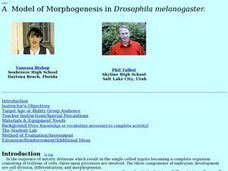Curated OER
A Model of Morphogenesis in Drosophila Melanogaster
Students investigate the following scientific terms and ideas: rates of diffusion, the role of morphogens in the development of larva, the chemical dynamics of a cell, and the significance of embryo polarity during development.
Curated OER
"Honey Dew from Bunny Too!"
The pupils will design a lab to test the mechanism that triggers spore dispersal. They should have some clues after making observations of the life cycle. Part of the fun here is to let the students devise a method for testing this...
Curated OER
AN EMBRYOLOGY PLACE MAT
Students create a place mat to attain the following objectives: determine the important ideas, concepts, and definitions relating to a list of embryological terms. Match the terms with their definitions and create short quizzes for them.
Curated OER
UV Radiation and the Developmental Stages of Red Flour Beetles
Students perform an experiment to compare the sensitivity of the various developmental stages of Red Flour Beetles to ultraviolet radiation. Larvae, pupae and adult beetles are exposed to a source of UV-B radiation. In groups, they...
Curated OER
Experiment on Minimal Segment Size Regeneration of Lumbriculus variegatus
The experiment allows students to observe regeneration of tailless and headless worm segments into complete individuals. Data of a completed experiment are included as well as a student activity sheet.
Curated OER
CONSTRUCTION OF A HEMOGLOBIN GENE
Students use research to see how eight pairs of triplets are equivalent to part of a gene and control a part of heredity. They also understand how red blood corpuscles manufacture normal hemoglobin.
Curated OER
Ethical Decision Making in Biology
Students explore a model that illustrates the spread of HIV through an adolescent population. Acting in the role of epidemiologists, students explore the dilemmas of HIV infection presented by a simulation. Students produce a play, skit,...
Curated OER
Biodiversity: El Imposible National Park, El Salvador
Fifth graders explore the concept of how the more diverse an ecosystem is, the more interdependence of species exists within that system. The complex relationships among diverse species are difficult to identify. As species disappear or...
Curated OER
Ocean Market
Young scholars research how: The ocean is the source of many materials, from ores mined from its depths to relaxing mineral salts for a bath. Exquisite mother-of-pearl inlay, decorative shells, and pearl jewelry are found in gift shops...
Curated OER
Pollen Collection And Identification
Learners investigate plant reproduction, pollen collection and identification. They collect pollen samples over a twenty four hour period and examine them under a microscope.
Curated OER
Windows on Life
Students explore and observe living development using live fertilized chicken eggs. They open the eggs approximately 72 hrs after fertilization and make observations for several days.
Curated OER
Plants
Students identify and label parts of a plant. They will construct a plant from art material and describe the purpose of each part for the plants survival. Students author a book with pictures and words or a story about a plant.
Curated OER
Spring Migration, Milkweed Monitoring
Pupils watch for milkweed plants from the previous fall and choose several new plants to monitor. Then make observations and measurements about the plants. The connection with the weather is also made with the monitoring of temperature,...
Curated OER
Data Collection and Record Keeping. Measuring Larval Growth and Development
Students keep data records of the growth of Monarch larvae. The observations are made with the change of each stage of development. The observations are to stimulate the answering of questions about biological development.
Curated OER
How does Temperature Affect Time in the Pupa Stage?
Young scholars are guided through the Scientific Method to perform observations about the pupa stage of the monarch butterfly. The results of an experiment are used to make assumptions about growth and development.
Curated OER
Lesson 4, Spring Migration. Milkweed Monitoring
High schoolers monitor the growth of milkweed plants. The observations are made to help make conclusions about growth and development.
Curated OER
Weather Conditions During the Spring Monarch Migration
High schoolers keep a detailed record of weather patterns during the spring migration of the monarch butterfly. The use of weather reports is used to form a class data sheet. This lesson connects to the skills of graphing and critical...
Curated OER
Camouflage in Animal Habitats
Young scholars investigate how animals in an ecosystem interact with a nonliving environment through camouflage. They work in cooperative groups to "go fishing" and record how many of each color of fish they "catch." After entering data...
Curated OER
Last Flight of Bomber 31
Students act as forensic scientists to help solve a long-standing missing persons case. They study nuclear DNA and mtDNA.
Curated OER
Extraction of DNA from White Onion
Students conduct lab test with minced onion to determine where chromosonal DNA is located within the cell, and whether or not it can be extracted.
Curated OER
Immune System Function
Students study the different facets of the Human immune system, including the functions of all the different organs in the immune system.
Curated OER
Bacterial Transformation Kit
Young scholars participate in an experiment in which they practice moving genes from one organism to another. They examine the results of a recombination of jellyfish. They identify different types of bacteria as well.
Curated OER
H2O in Us
Students discover through this activity that all organisms are composed of water. They find that 70 percent of their bodies are made up of water that is in thier cells and blood, and not free-flowing throughout their body.
Curated OER
Trees!
Young scholars are introduced to the parts of trees through discussion and participation in learning centers with hands on activities that focus on each part.

























